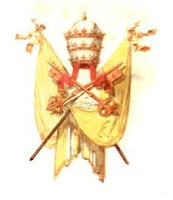DURING A RECENT TRIP TO VENICE, I PULLED OUT AND PERUSED John Ruskin's The Stones of Venice,* and dogeared for later reference the pages that contained the following observations by Ruskin about the "moral character" of an arch, and how it is analogous to the moral character of man. I thought I would include it in the lull between the last series of substantive postings and the next on Jacques Maritain, sort of as an interlude or intermission.
Like men and their societies, of which the variety is legion throughout the course of time and place, the world is full of different kinds of arches. Arches vary one from each other, and reflect the contingencies of time and place, cultural influence, available materials, the wealth of the builder and society, technology, and even a bit of arbitrary whim and individual self-expression. Part of their beauty is their vast variety and virtual infinity of expression. Arches are, and ever should be, different. Vive la différence!
And yet, their variety withal, arches are recognizable as arches. Only a fool would maintain that because they show variety, there is no such thing as the nature of an arch. Arches have a fundamental nature, and as part of that nature, intrinsic rules they must follow. The failure to follow the fundamental rules results in their collapse. All arches share, therefore, some fundamental similarities and must follow one law. Vive le Similarité!
The same is true for man. With all the variety we find in men and his social ensembles, there remains in him a fundamental law of nature that must be met, or else he is not a man or acts not like man ought to act. It is true, he must adapt to his circumstance, to the contingencies of time and place, to his culture, the resources that surround him, the technologies available to him, and so forth. While immutable in basics and in certain precepts, it also allows for legitimate adaptation to time and place. There is not one law for the lion and one for the ox, but the same one law adapts the lion and to the ox. But for all the legitimate variety, there is a central "moral character," what is called the natural law, which is analogous to the "Line of Resistance" or "arch line" in the arch referred to by Ruskin, and it is the limit beyond which the arch cannot go without failure. Nor can man transgress the natural law without moral failure.
Here, we think, is a valuable analogy, or perhaps better, metaphor, for the natural law and both its immutable character and ability to manifest itself and adapt to the temporal and circumstantial contingencies in which men find themselves.
_________________________________________
*From John Ruskin, The Stones of Venice (ed. and abridged by J. G. Links) (London: Penguin Books, 1960), 68-69.
Like men and their societies, of which the variety is legion throughout the course of time and place, the world is full of different kinds of arches. Arches vary one from each other, and reflect the contingencies of time and place, cultural influence, available materials, the wealth of the builder and society, technology, and even a bit of arbitrary whim and individual self-expression. Part of their beauty is their vast variety and virtual infinity of expression. Arches are, and ever should be, different. Vive la différence!
And yet, their variety withal, arches are recognizable as arches. Only a fool would maintain that because they show variety, there is no such thing as the nature of an arch. Arches have a fundamental nature, and as part of that nature, intrinsic rules they must follow. The failure to follow the fundamental rules results in their collapse. All arches share, therefore, some fundamental similarities and must follow one law. Vive le Similarité!
The same is true for man. With all the variety we find in men and his social ensembles, there remains in him a fundamental law of nature that must be met, or else he is not a man or acts not like man ought to act. It is true, he must adapt to his circumstance, to the contingencies of time and place, to his culture, the resources that surround him, the technologies available to him, and so forth. While immutable in basics and in certain precepts, it also allows for legitimate adaptation to time and place. There is not one law for the lion and one for the ox, but the same one law adapts the lion and to the ox. But for all the legitimate variety, there is a central "moral character," what is called the natural law, which is analogous to the "Line of Resistance" or "arch line" in the arch referred to by Ruskin, and it is the limit beyond which the arch cannot go without failure. Nor can man transgress the natural law without moral failure.
Now the arch line is the ghost or skeleton of the arch; or rather it is the spinal marrow of the arch, and voussoirs are the vertebrae, which keep it safe and sound, and clothe it. This arch line the architect has first to conceive and shape in his mind, as opposed to, or having to bear, certain forces which will try to distort it this way and that; and against which he is first to direct and bend the line itself into as strong resistance as he may, and then, with his voussoirs and what else he can, to guard it, and help it, and keep it to its duty and in its shape. So the arch line is the moral character of the arch, and the adverse forces are its temptations; and the voussoirs, and what else we may help it with, are its armour and its motives to good conduct.
This moral character of the arch is called by architects the "Line of Resistance." There is a great deal of nicety in calculating it with precision, just as there is sometimes in finding out very precisely what is a man's true line of moral conduct: but this, in arch morality and in man morality, is a very simple and easily to be understood principle,--that if either arch or man expose themselves to their special temptations or adverse forces, outside of their voussoirs or proper and appointed armour, both will fall. An arch whose line of resistance is in the middle of its voussoirs is perfectly safe: in proportion as the said line runs near the ed of its voussoirs, the arch is in danger, as the man is who nears temptation; and the moment the line of resistance emerges out of the voussoirs the arch falls.
Here, we think, is a valuable analogy, or perhaps better, metaphor, for the natural law and both its immutable character and ability to manifest itself and adapt to the temporal and circumstantial contingencies in which men find themselves.
_________________________________________
*From John Ruskin, The Stones of Venice (ed. and abridged by J. G. Links) (London: Penguin Books, 1960), 68-69.








No comments:
Post a Comment